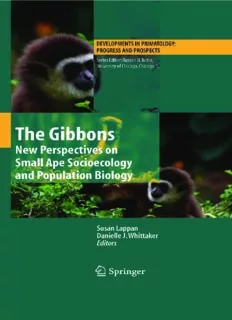
The Gibbons: New Perspectives on Small Ape Socioecology and Population Biology PDF
Preview The Gibbons: New Perspectives on Small Ape Socioecology and Population Biology
THE GIBBONS DEVELOPMENTSINPRIMATOLOGY:PROGRESSANDPROSPECTS StevenT.Rosen,MD,SeriesEditor This peer-reviewed book series melds the facts of organic diversity with the continuity of the evolutionary process. The volumes in this series exemplify the diversity of theoretical perspectives and methodological approaches currently employed by primatologists and physical anthropologists. Specific coverage includes: primate behavior in natural habitats and captive settings; primate ecology and conservation; functional morphology and developmental biology of primates; primate systematics; genetic and phenotypic differences among living primates;andpaleoprimatology. Forothertitlespublishedinthisseries,goto www.springer.com/series/5852 THE GIBBONS New Perspectives on Small Ape Socioecology and Population Biology Edited by Susan Lappan EwhaUniversity Seoul RepublicofKorea and Danielle J. Whittaker IndianaUniversity Bloomington,IN USA Foreword by David J. Chivers 1 3 Editors SusanLappan DanielleJ.Whittaker EwhaUniversity IndianaUniversity Seoul Bloomington,IN RepublicofKorea USA [email protected] [email protected] ISBN978-0-387-88603-9 e-ISBN978-0-387-88604-6 DOI10.1007/978-0-387-88604-6 LibraryofCongressControlNumber:2008942050 #SpringerScienceþBusinessMedia,LLC2009 Allrightsreserved.Thisworkmaynotbetranslatedorcopiedinwholeorinpartwithoutthewritten permissionofthepublisher(SpringerScienceþBusinessMedia,LLC,233SpringStreet,NewYork, NY10013,USA),exceptforbriefexcerptsinconnectionwithreviewsorscholarlyanalysis.Usein connectionwithanyformofinformationstorageandretrieval,electronicadaptation,computer software,orbysimilarordissimilarmethodologynowknownorhereafterdevelopedisforbidden. Theuseinthispublicationoftradenames,trademarks,servicemarks,andsimilarterms,evenifthey arenotidentifiedassuch,isnottobetakenasanexpressionofopinionastowhetherornottheyare subjecttoproprietaryrights. Printedonacid-freepaper springer.com Foreword It is a great honor to be asked to introduce this exciting new volume, having been heavily involved in the first comprehensive synthesis in the early 1980s. Gibbons are the most enthralling of primates. On the one hand, they are the most appealing animals, with their upright posture and body shape, facial markings, dramatic arm-swinging locomotion and suspensory postures, and devastatingduets;ontheotherhand,thesmallapesarethemostdiverse,hence biologicallyvaluableandinformative,ofourclosestrelatives. Itishardformetobelievethatitis40yearstothemonthsinceIfirstsetfoot on the Malay Peninsula to start my doctoral study of the siamang. I am very proud to have followed in the footsteps of the great pioneer of primate field study,ClarenceRayCarpenter(CRorRay,whoIwasfortunatetomeettwice, inPennsylvaniaandinZurich),firstinCentralAmerica(in1967)andthenin Southeast Asia. It is 75 years since he studied howler monkeys on Barro ColoradoIslandinthePanamaCanalZone.Itis70yearssincehestudiedthe white-handedgibboninThailand. Raywasaremarkablemanforinitiatingthiskindofstudyandfordoingitso well, so perceptively. Perhaps because the howler population had increased markedly over 30 years, I was able to make an original contribution to the understandingoftheroleofdawncallsinthespacingofgroups,showingthey avoided their neighbors in any month and lived in overlapping home ranges, thattheywerenotterritorialintheclassicsense.Bycontrast,almosteverytimeI thoughtIhaddiscoveredsomethingnewaboutgibbonbehavior,Ifoundthatif Rayhadnotseenit,hesuggestedthatitmighthappen! TheonlyotherstudentofgibbonbehaviorwasJohnEllefson,whostudied thewhite-handedgibbonincoastalforestofeastJohore,WestMalaysia,inthe early 1960s. He produced some excellent results, but few of his data are presented in a manner that allowed full comparison with other studies. I was fortunate to encounter him in the redwoods of California before heading for Malaysia, where I met Naoki Koyama, from the Primate Research Institute, Kyoto,whowastacklingtheimpossibletaskofstudyingsiamangintherugged terrainofFraser’sHill.Thus,Iinheritedaframeworkofgibbonsocioecology based on monogamy, territoriality, frugivory, suspensory behavior, and v vi Foreword duetting (loud melodic group calls/songs), on which we have built over the years. Susan Lappan and Danielle J. Whittaker are to be congratulated on their very real achievement of bringing together such a breadth and wealth of new information on gibbon biology, spread over two IPS Congresses. There is an impressive blend of biogeography and phylogeny, diets and community ecology, ecology and social organization, mating systems and reproductive biology, and conservation biology. The lack of material on anatomy was a deliberatedecision,becauseithasbeendealtwithpreviously,especiallyinthe 1984 synthesis. Readers are reminded of this first conference and book on gibbonbiology.SchlossReisensburg,thecastleontheDanubenearUlm,was anamazingandstimulatingvenueforourveryproductiveconferencein1980, away from the IPS Congress in Florence (which thankfully rejected our symposium proposal, even as a satellite event!). The more formal sessions in thecastlelectureroomwereaugmentedbygenuineround-tablediscussions,in theturretsclosetofridgesfullofGermanbeerandwine!Thesesessions,going onlateintothenight,wereveryproductiveinreachingconsensus. Theeditors’introductorychapteronsmallapediversityandtheimportance ofpopulation-levelstudiessetsoutclearlythescopeandcontentsofthebook. Quantifyingtheroleofgibbonsinseeddispersalisamajoradvance.Gibbons mayliveinsmallterritories,buttheyaremoreeffectiveindispersalthanthose travelinggreaterdistances,oftendepositingseedsontounsuitableground.Iam reassuredthatthisintensive‘farming’oftheforestismosteffective,especiallyin the light of numerous tree-falls and such opportunities for natural forest regeneration. Perhaps the most exciting new development is the collection of DNA by noninvasive methods to determine genetic relationships within and between gibbon families, particularly to identify paternity. This is an essential aid to understandingthemore complex social systems now beingdescribed.Wewill have to await the publication of such results. Systematics and taxonomy is anotherareawithacurrentflurryofactivity,whichshouldsoonseethelightof dayelsewhere. I am reminded of the conflict generated by the novel use of molecular evidence 30 years ago in defining hominoid relationships and evolution. Whilepaleontologistsandanatomistsclaimedthattheape–humanseparation wasabout14–12Mya,themolecularbiologistssuggested5Mya,buttheyhad not allowed for increased generation time. The compromise between the two disciplines was resolved at7–9 Mya, corresponding withthe major gap inthe fossil record. The DNA story, of closest affinity between African apes and humans, has reawoken the major reservation in those who have shown that ancestral Asian apesshare derivedmorphologicalfeatures, incompatible with themolecularevidence.Ithinkwemaybemissingsomethingwiththecurrent obsessionwiththegenotype,ratherthanthephenotype.Iliveinhopethatitwill beshowneventuallythatwearedescendedfromthelovelyAsianapes,rather thanthoseunattractiveandpromiscuousAfricanapeswithswollenbottoms! Foreword vii Ialsowanttocautionagainst‘swinging’toofarawayfromthemonogamy and territoriality as originally assigned to gibbons. I am very happy to acknowledgetheflexibilitythatitisentirelyappropriatetoassigntoapesand their social systems, and the importance of long-term studies. The fact of the matteristhat,inthehumidtropicsatleast(theSundaicregionoftheOriental realm),monogamousfamiliesinterritoriesarethenorm,atleastforthelifetime oftheindividualsconcerned.Ihaveseenthisover20yearsinbothPeninsular Malaysia and Indonesian Borneo, and heard of it elsewhere. The exceptions nowbeingencounteredmorefrequentlyanddescribedmoreforcefullyseemto metoberelatedclearlytoisolated,disturbed,orfragmentedhabitats,andthe various problems of overcrowding or imbalanced sex ratios associated with that. Extra-pair copulations, polygyny, and polyandry are fascinating reflectionsoftheabilitiesandsocialflexibilityofgibbons,andtheyneedtobe documented fully and interpreted carefully, without rejecting the key, basic, socioecological adaptations, which separated gibbons from orangutans, langurs,andmacaques. Stillmorespeciesandsubspeciesofgibbonsarebeingdescribed,somevery endangered, especially in southern China (including Hainan), northern Vietnam,westernJava,Bangladesh/Assam,and,probably,Myanmar.Allare threatened, some critically. Continuing to publicize and promote action to resolve such crises is urgently needed. The classification of the gibbons of Borneo, in relation to those of Sumatra and Malaya, needs to be resolved. What are the true identities of the species and subspecies? Are agile and Mueller’sgibbonsonespeciesorseveral? Thus,Icommendyoutothisfeastofnewinformationanddiscussiononso many aspects of gibbon biology, so well assimilated by Susan and Danielle. I hope that it will inspire continued research and the quest for understanding these,themostimportantofall,primates! Cambridge,UK DavidJ.Chivers Acknowledgments The editors thank the following individuals: David J. Chivers for advice, discussion, and encouragement; Thomas Geissmann for organizing the first gibbonsymposium atthe2002InternationalPrimatological SocietyCongress andforhisassistancewiththisvolume;LarissaSwedellforhelpfulcomments ontheintroductorychapter;RussellTuttleforinvitingustosubmitthisedited volume;andallofthecontributorsfortheirhardworkandpatience.Wethank EwhaUniversityandIndianaUniversityforsupportduringthecompletionof this volume, and the New York Consortium in Evolutionary Primatology (NYCEP) for support at the beginning of the process. We are grateful to the countries that are home to gibbon populations for permission to conduct studies,andtothemanyorganizationsthathavefundedgibbonresearch. Seoul SusanLappan Bloomington,IN DanielleJ.Whittaker ix Contents PartI Introduction 1 TheDiversityofSmallApesandtheImportanceof Population-LevelStudies .................................. 3 DanielleJ.WhittakerandSusanLappan PartII Biogeography 2 EvolutionaryRelationshipsAmongtheGibbons:A BiogeographicPerspective ................................. 13 HelenJ.Chatterjee 3 GeneticDifferentiationofAgileGibbonsBetweenSumatra andKalimantaninIndonesia ............................... 37 HirohisaHirai,AzusaHayano,HiroyukiTanaka,Alan R.Mootnick,HeryWijayanto,andDyahPerwitasari-Farajallah 4 VocalDiversityofKloss’sGibbons(HylobatesKlossii) intheMentawaiIslands,Indonesia........................... 51 SallyA.Keith,MelissaS.Waller,andThomasGeissmann 5 PhylogeographyofKloss’sGibbon(HylobatesKlossii) PopulationsandImplicationsforConservationPlanning intheMentawaiIslands................................... 73 DanielleJ.Whittaker 6 IndividualandGeographicalVariabilityintheSongsofWildSilvery Gibbons(HylobatesMoloch)onJava,Indonesia................ 91 RobertDallmannandThomasGeissmann 7 TheFossilRecordofGibbons............................... 111 NinaG.JablonskiandGeorgeChaplin xi
Description: